Greek euro coins
Greek euro coins feature a unique design for each of the eight coins. They were all designed by Georgios Stamatopoulos with the minor coins depicting Greek ships, the middle ones portraying famous Greeks and the two large denominations showing images of Greek history and mythology. All designs feature the 12 stars of the EU, the year of imprint and a tiny symbol of the Bank of Greece. Uniquely, the value of the coins is expressed on the national side in the Greek alphabet, as well as being on the common side in the Roman alphabet. The euro cent is known as the lepto (λεπτό; plural lepta, λεπτά) in Greek.
Greece did not enter the eurozone until 2001 and was not able to start minting coins as early as the other eleven member states, so a number of coins circulated in 2002 were not minted in Athens but in Finland (€1 and €2 – mint mark S), France (1c, 2c, 5c, 10c and 50c – mint mark F) and Spain (20c - mint mark E). The coins minted in Athens for the euro introduction in 2002 as well as all the subsequent Greek euro coins do not carry any mint mark.
Contents |
Greek euro design
For images of the common side and a detailed description of the coins, see euro coins.
| € 0.01 | € 0.02 | € 0.05 |
|---|---|---|
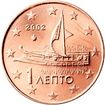 |
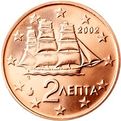 |
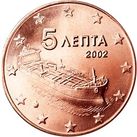 |
| An Athenian trireme of the 5th century BC | A corvette (or dromon) of the early 19th century | A modern tanker, symbol of Greek enterprise |
| € 0.10 | € 0.20 | € 0.50 |
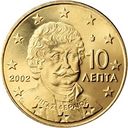 |
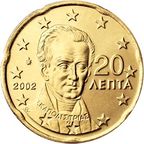 |
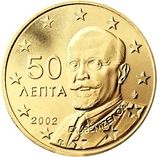 |
| Rigas Feraios, Greek writer and revolutionary | Ioannis Kapodistrias, Greece's first statesman | Eleftherios Venizelos, Greek politician |
| € 1.00 | € 2.00 | € 2 Coin Edge |
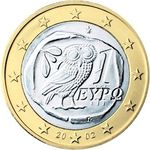 |
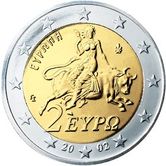 |
The words Hellenic Republic in Greek script (ΕΛΛΗΝΙΚΗ ΔΗΜΟΚΡΑΤΙΑ) |
| Picture of a 5th century BC 4 drachma coin of Athens (a coin in a coin) | The abduction of Europa by Zeus in the form of a bull |
Circulating Mintage quantities
The following table shows the mintage quantity for all Greek euro coins, per denomination, per year (the numbers are represented in millions).[1]
| Face Value | €0.01 | €0.02 | €0.05 | €0.10 | €0.20 | €0.50 | €1.00 | €2.00 | |||||||||
|---|---|---|---|---|---|---|---|---|---|---|---|---|---|---|---|---|---|
| 2002 | 100.94 | 175.94 | 210.94 | 138.94 | 208.94 | 92.94 | 61.44 | 75.34 | |||||||||
| 2002 EFS | 15.0 | 18.0 | 90.0 | 100.0 | 120.0 | 70.0 | 50.0 | 70.0 | |||||||||
| 2003 | 35.1 | 9.4 | 650.7 | 500.7 | 700.7 | 600.7 | 11.60 | 450.7 | |||||||||
| 2004 | 49.97 | 24.97 | 220.0 | 9.97 | 470.0 | 470.0 | 9.97 | *** | |||||||||
| 2005 | 14.95 | 14.95 | 950.0 | 24.95 | 950.0 | 950.0 | 9.95 | 0.95 | |||||||||
| 2006 | 44.95 | 44.95 | 49.95 | 44.95 | 950.0 | 950.0 | 9.95 | 0.95 | |||||||||
| 2007 | 60.03 | 25.0 | 55.0 | 60.04 | 0.95 | 0.95 | 24.17 | *** | |||||||||
| 2008 | 24.0 | 68.0 | 50.0 | 40.0 | 20.0 | 10.0 | 4.0 | 1.0 | |||||||||
| 2009 | 49.975 | 15.975 | 37.975 | 45.975 | 23.975 | 6.975 | 17.975 | 0.975 | |||||||||
| 2010 | 27.0 | 31.0 | 5.0 | 5.0 | 12.0 | 6.0 | 11.0 | 1.0 |
* No coins were minted that year for that denomination |
||||||||
Future changes to national sides
The European Commission issued a recommendation on 19 December 2008, a common guideline for the national sides and the issuance of euro coins intended for circulation. One section of this recommendation stipulates that:
| “ | Article 2. Identification of the issuing Member State:
The national sides of all denominations of the euro coins intended for circulation should bear an indication of the issuing Member State by means of the Member State’s name or an abbreviation of it. |
” |
A new design on the Greek euro coins is expected in the near future to comply with these new guidelines, although nothing has officially been announced.[2]
€2 commemorative coins
 Summer Olympics in Athens (2004) |
 50th Anniversary of the Signature of the Treaty of Rome (2007) |
 Ten years of Economic and Monetary Union (EMU) and the birth of the euro (2009) |
Other commemorative coins (Collectors' coins)
Greece has a good collection of euro commemorative coins, mainly in silver although a few coins have also been minted in gold. Their face value range from €10 to €200 euro. This is mainly done as a legacy of an old national practice of minting gold and silver coins. These coins are not really intended to be used as means of payment, so generally they do not circulate. Here you can find some samples:
 Common side of the six gold coins minted to celebrate the Summer Olympics 2004. |
 Gold, 200 euro, 75th anniversary of Bank of Greece (2003) |
 Silver, 10 euro, Patras European Capital of Culture (2006) |
 Silver, 10 euro, Acropolis Museum (2008) |
References
- ↑ "Circulating Mintage quantities". Henning Agt. http://www.euro-auflagen.de/index.php?lang=en. Retrieved 2008-08-22.
- ↑ "Recommendation of 19 December 2008 on common guidelines for the national side of euro coins". The Euro Information Website. 14 January 2009. http://www.ibiblio.org/theeuro/forum/viewtopic.php?f=3&t=413. Retrieved 14 January 2009.
External links
- Bank of Greece
- 2004 Greek €2 commemorative coin
- The Euro Information Website – Greece
- Common guidelines for the national sides of euro circulation coins
|
||||||||||||||||||||||||||||||||||||||||||||||||||||